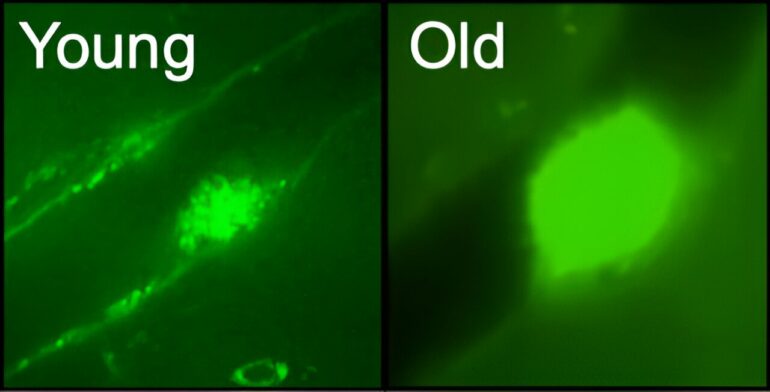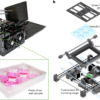As people age, they become more prone to blood clotting diseases, when blood cells called platelets clump together when they don’t need to and can cause major issues such as strokes and cardiovascular disease. For decades, scientists have studied why older people’s blood cells behave in this way, using their insights to develop the myriad of blood-thinning drugs now on the market for treating the leading cause of death in the United States.
Now, UC Santa Cruz Professor of Biomolecular Engineering Camilla Forsberg and her research group have discovered a distinct, secondary population of platelets that appears with aging and have hyperreactive behavior and unique molecular properties, which could make them easier to target with medication.
The researchers traced this population of platelets to its stem cell origins, finding what they identify as the first-ever-discovered age-specific development pathway from a stem cell to a distinct mature platelet cell.
“The question for decades and decades has been: why are aging people at such high risk for excessive blood clotting, stroke, and cardiovascular disease?” Forsberg said. “We have this discovery of a whole new pathway that progressively appears with aging—troublemakers! That was never part of the discussion.”
The research group present their findings in a paper published in Cell. First author Donna Poscablo, Forsberg’s former Ph.D. student who is now a postdoctoral scholar at Stanford University, and her peers carried out these experiments with the resources and training environment at the Institute for the Biology of Stem Cells (IBSC) at UC Santa Cruz.
Understanding platelets
Platelet cells are one of three types of blood cells produced by the body, with red and white blood cells being the other two. Millions of these cells float around in the blood at all times, and when an injury occurs either internally or externally, they clot together to form a natural, living bandaid.
Platelet dysregulation, which is known to increase with age, occurs when these cells are either hyperreactive and form clots too often, or are underperforming. In both cases the body can’t properly manage bleeding and clotting, although hyperreactivity is a much more widely-seen problem.
All blood cells begin as hematopoietic stem cells, a special class of stem cells, and then mature through a series of intermediary steps called a “differentiation pathway” that lead them to their fate as either platelets, red blood cells, or white blood cells. It’s been known for decades that these hematopoietic stem cells decline with age, but that presents a contradiction for scientists: if the hematopoietic cells are less healthy, then why are the platelets they create hyperreactive?
A ‘shortcut’ pathway
As stem cell biologists, the researchers at UC Santa Cruz approached this question by investigating the hematopoietic stem cells.
They conducted experiments that allowed them to trace the lineages of these stem cells in mouse models, and discovered that in aged mice some of their platelets did not travel along the differentiation pathway.
Instead, they took what the UCSC researchers dubbed a “shortcut” pathway, skipping over the intermediary steps and immediately becoming megakaryocyte progenitors, the blood cell stage immediately before platelet production. To the researchers’ knowledge, this is the first age-specific stem cell pathway ever discovered.
“People think of [platelets and red blood cells] as one lineage that shares regulation and intermediate stages until the very end,” Forsberg said. “To see that [the secondary platelet population] were completely separated all the way from the stem cell level, only in aged mice, was really surprising.”
While the population of platelets produced from the shortcut pathway are hyperreactive, the platelets produced from the main pathway continue to behave like the platelets in a young person.
“The gradual differentiation cascade maintains a youthful property, and I feel like that is also surprising within itself,” Poscablo said.
They found that the hyperreactive secondary platelets start to be produced around midlife for the mice, with their population growing progressively with aging. As of now, the researchers have not found a trigger that begins the production of this secondary pathway.
Unexpectedly, however, it does not seem to be triggered by the aging environment itself: when a young hematopoietic stem cell is transferred into an aged environment, it doesn’t seem to trigger the shortcut pathway; and when an aged hematopoietic stem cell is put into young environment, the old stem cells continue to operate as old stem cells.
“That was surprising, the age resilience of the other pathway,” Forsberg said. “One of the platelet populations is not affected at all [by aging], whereas the one we have discovered is—so the whole phenomenon is not primarily induced by the environment, but by the differentiation path.”
Choosing better treatments
Knowing that this secondary population of platelets exists will help researchers find new ways to target and regulate these problematic cells via their stem cells. Before this, researchers have not tried to target these upstream cells.
“From our expertise, we can ask the questions of how to target the hematopoietic stem cell and now the megakaryocyte progenitor, which has never really been highlighted before as a place to target,” Poscablo said.
Targeting these cells may not require the creation of new medications, but more simply inform the prescription of existing blood thinners such as aspirin, which treat different patients to varying degrees even if they present with similar clotting-related symptoms. Using their mouse models, the researchers will identify which of the two populations of stem cells are more sensitive to aspirin and the myriad of other platelet drugs on the market.
The UCSC researchers are also currently working on finding this secondary population of platelets in human cells. In the mouse models, they will continue to study how to manipulate and control the shortcut pathway.
More information:
An age-progressive platelet differentiation path from hematopoietic stem cells causes exacerbated thrombosis, Cell (2024). DOI: 10.1016/j.cell.2024.04.018. www.cell.com/cell/fulltext/S0092-8674(24)00413-6
Provided by
University of California – Santa Cruz
Citation:
Study discovers distinct population of ‘troublemaker’ platelet cells appear with aging (2024, May 14)



